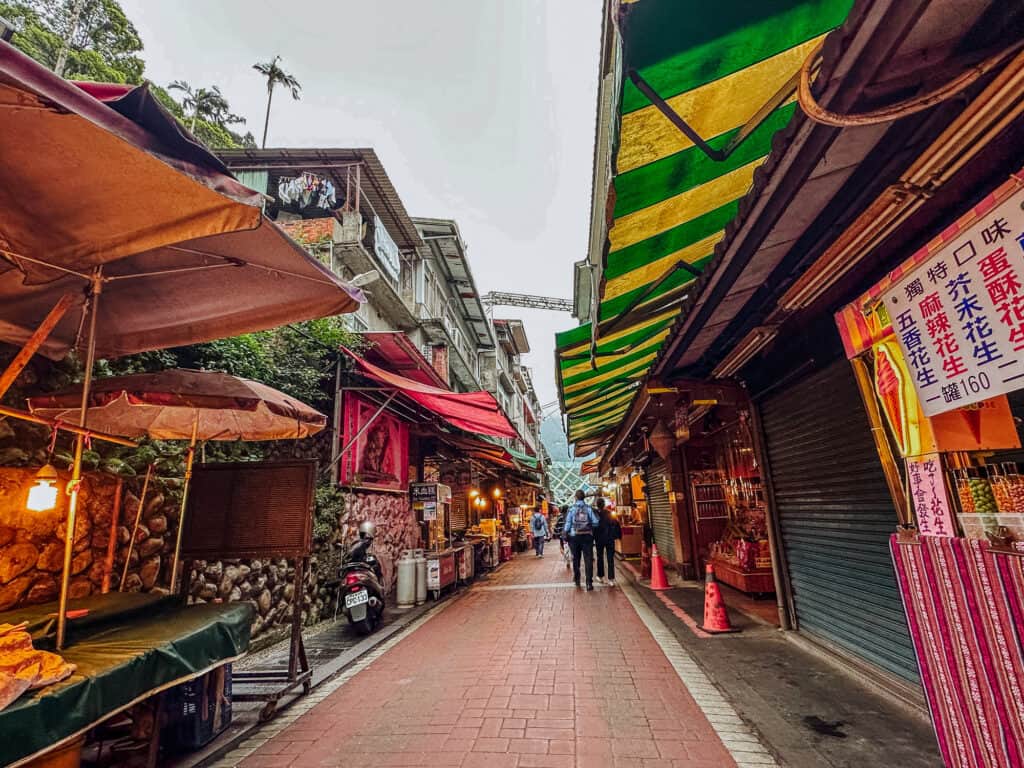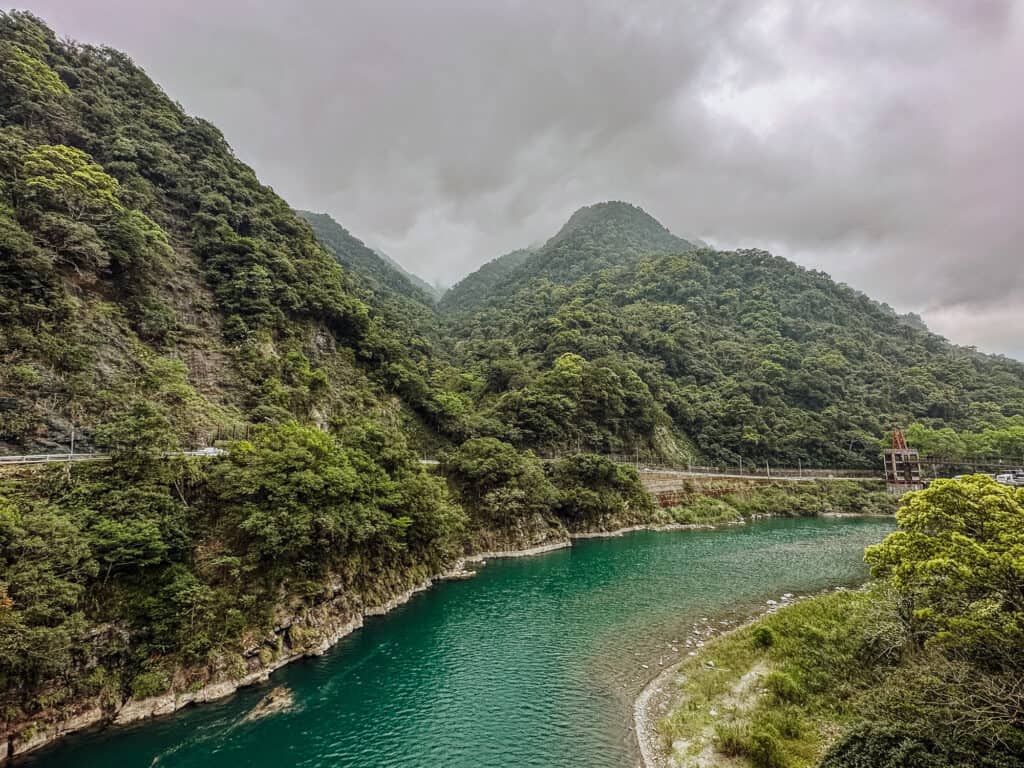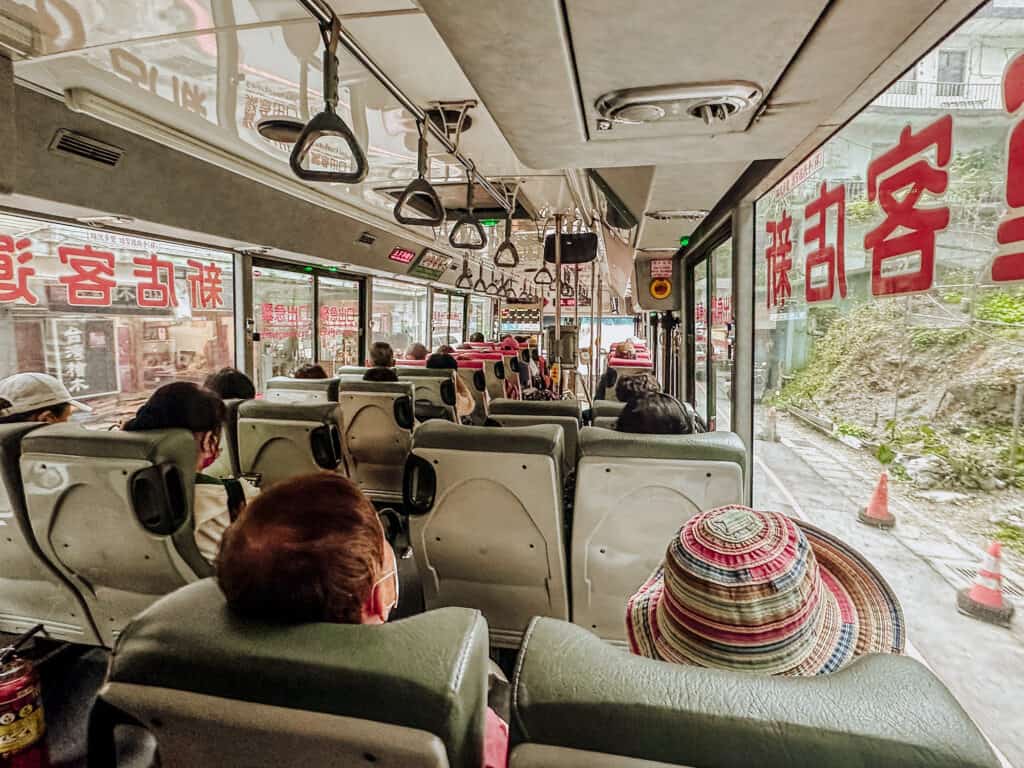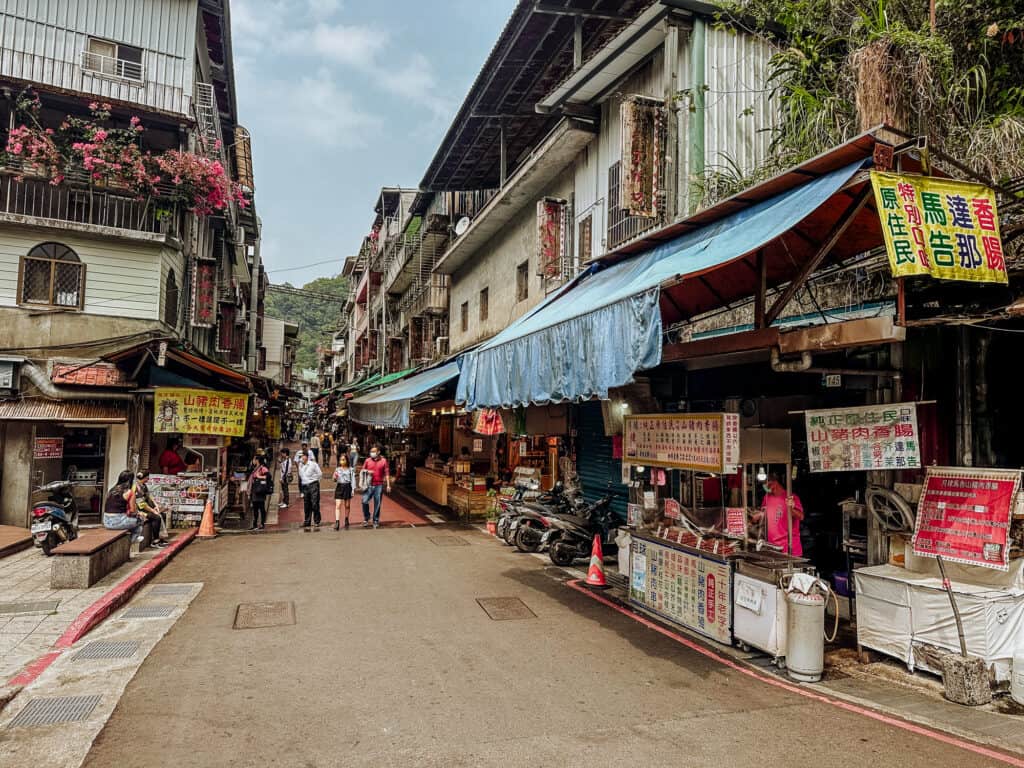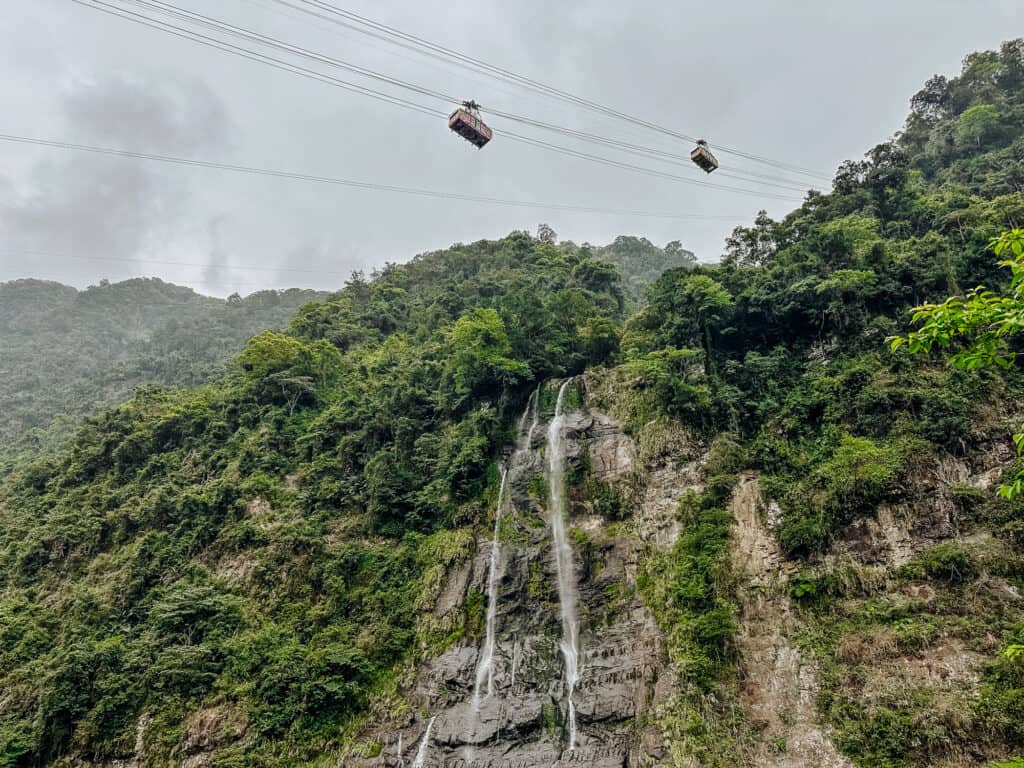Guide to Wulai, Taiwan: The Old Street, Hot Spring, Waterfalls, & More
VISIT WULAI, TAIWAN: TRAVEL GUIDE FOR A GREAT DAY TRIP!
The Wulai District is south of Taipei, Taiwan, and is a great day trip destination.
Wulai is easy to get to from Taipei, and the trip should take just about an hour. You can get to Wulai using a combination of the subway (MRT) and bus system, or a taxi from the city.
KEY TAKEAWAYS
While traditionally, Wulai is well known as a hot spring destination in Taiwan, the springs rank low on my list of reasons to visit the area.
The natural beauty of the waterfalls and winding river, plus the local history and Old Street market are well worth the journey to Wulai.
Day Trip: Taipei to Wulai
This is one of our favorite day trips from Taipei. It’s best to go when it’s not raining, unless you’re heading specifically to one of the hot spring spas.
Wulai is easy to get to from Taipei, even if you don’t speak the language and don’t have much experience with public transportation in Taiwan. Plus the whole journey will only cost you a couple dollars!
Wulai from Taipei by Train
No train runs directly from Taipei to Wulai, but you can take the subway at least partially there.
From Taipei, take the MRT (subway) to the last stop on the Green Line, which is Xindian.
At Xindian Station, head outside at look for the bus that will take you to Wulai.
Wulai from Taipei by Bus
The train doesn’t run from Taipei all the way to Wulai. Instead, the road follows the winding Nanshi River through the mountains outside the city.
From Xindian Station, look for Bus 849. You’ll find the bus stop right outside the train station. Just line up with the others who will likely be there waiting for the same bus.
It runs at least four times per hour, so you won’t be waiting long. Bring change to drop in the payment container as you board. It should be 15 TWD per person, which is about 50 cents (USD).
The bus ride to Wulai can take as long as 45 minutes, depending on how many stops people onboard request along the way. It’s more likely to take about 30 minutes.
You’ll be on the bus mostly with local people who live in the villages between Taipei and Taiwan.
You can take the bus right to the main bus station in Wulai, but I’d suggest getting off a stop earlier, at Tourism Bridge. It’s a very short walk across the bridge into town.
Wulai from Taipei by Taxi / Car
This advice goes for anyone going from Taipei to Wulai: if you suffer from motion sickness, take non-drowsy Dramamine or something similar before you go! The road is windy and hilly, and the drivers lean into all the twists and turns.
Taxis are a fixed price: $22 USD for a one-way trip to Wulai, from Xindian Station in Taipei.
The taxi driver will drop you off right at the main bus station in Wulai. Later, you’ll be able to find another driver in the same spot to take you back to Taipei.
Wulai Hotels: Where to Stay
I think Wulai is the perfect day trip from Taipei, but it’s home to several hotels (and hot spring spas, which also double as hotels). If you’re looking to spend a quiet night outside the big city, Wulai might be the place!
You can click on this interactive map to find the hotel and rental options available in and around Wulai:
Wulai Waterfall
A lot of tourists visit Wulai specifically for the waterfall hike. The waterfall is incredibly high, at 260 feet, and quite beautiful.
While it’s definitely worth a visit, you shouldn’t expect to go on one of Taiwan’s scenic tree-lined hiking trails to get there. It’s more of a one-mile walk up a paved road from Wulai’s bus station to the waterfall viewing area.
Plus, this is not a waterfall you can actually get close to or swim in.
Instead, you’ll find several cliff-side restaurants and cafes with patios overlooking the falls and the mountainside.
If you’d rather not walk along the road through Wulai to get to the waterfall, you can also take the mini tram, called the Log Cart or “scenic train” to get there. More on that down below!
Wulai Hot Springs
Even in the airport on our way to Taipei, people were suggesting a visit to the hot springs in Wulai.
While water from the hot springs is used in all of the spas which line the streets of Wulai, you can no longer swim in the natural springs yourself.
It took me a while to figure this out, since there’s so much chatter about Wulai’s hot springs!
People who live there finally filled me in.
Across the Nanshi River from Wulai’s Old Street, you can see the remnants of what used to be a large public pool. It sat on the bank of the river, and was fed by water from the hot springs.
In 2015, a damaging typhoon swept through Taiwan. It brought severe flooding and triggered massive mudslides in Wulai. The storm destroyed the free, open-air hot spring pool.
Wulai’s Hot Spring Spas:
Now, you’ll see a maze of pipes running along the Nanshi River, bringing water from the natural hot springs to the spas. The spas offer a much more manufactured hot spring experience in Wulai these days.
You’ll find several along the Old Street, and also on the other side of the river, offering soaks in hot spring water baths for between 100 – 1200 TWD for an hour. That’s about $5 – $40 USD for an hour.
Here are a few photos of what you can expect. Some of the baths overlook the river:
Wulai’s Hot Springs: The History
To give you an idea of the importance of hot springs to the Wulai area: the word “Wulai” is derived from a term that means “boiling hot spring” in the native Atayal language.
The water from the hot springs in Wulai is said to contain sodium bicarbonate, which some say is effective at removing old skin and boosting metabolism. People say a plunge in the hot spring water will leave them with much softer skin.
Visit Wulai’s Old Street & Market
I wasn’t expecting to love Wulai’s Old Street as much as I did! It was probably my favorite part of the day trip from Taipei.
Wulai’s market is a short walk into town from the bus station.
You’ll find dozens of local vendors, chefs, and business owners selling food, crafts, and other goods.
Some shops will offer fresh fruits and vegetables.
I was in awe of the giant sacks of dried mushrooms, the seafood selection, and meat options.
The Wulai Scenic Train [Trolley/Log Cart]
Wulai’s Log Cart will take you up into the hills, and also along the road outside town right to the waterfall viewing area. The trains run from 9:00am – 5:00pm daily.
The cost of the one-kilometer train ride is 50 TWD, which is less than $2 USD. Earlier in the day, you won’t have to wait at all. Other times, you’ll have to cue in a lengthy line for a spot on the trolley.
History of the Scenic Train / Log Cart
No matter what you call Wulai’s train, the history behind it is pretty neat:
- 1920s-1960s: The logging industry in Wulai was booming. The rail line was built to transport logs and machinery. The original carts were man-powered.
- 1960s-1970s: In addition to transporting local people around Wulai, the train became popular with tourists. Seats, handrails, canvas tops, and other safety features were added. A second track was added from Wulai to the waterfall.
- Mid-1970s: Engines were added to the Wulai train cars, increasing speed and capacity on the uphill run to the waterfall area. One the way back down the hill, the train cars would coast, with the brakes under the control of a worker onboard.
- 1980s: New features for passenger comfort were added. They included curtains to block the wind and rain, and footrests.
- 1990s: New carts, made of fiberglass, debuted on the Wulai log cart line. Crews also dug a tunnel at the waterfall end of the tracks, making it easier for the trains to reverse direction.
- 2000s: New cars were designed, with a traditional Atayal theme. Some were painted with the cherry blossoms Wulai is famous for.
- 2015: Typhoon Soudelor caused erosion and mudslides, wrecking the foundation of the tracks Wulai’s scenic tram had used for decades.
- 2017: Repairs to the mountainside and tracks were completed, and the tram started running again with the brightly-colored paint schemes you can still see today.
Other Things to do in Wulai
Just walking around town, you’ll come across many more things to check out. Many of them have links to Wulai’s Atayal tribal roots.
The Suspension Bridge
One of the first landmarks you’ll spot pulling into Wulai is the suspension bridge that crosses the river. There’s a temple on one side, and the bus station / taxi depot on the other. It’s pretty for pictures, and convenient for locals to use in town.
The Wulai Cable Car / Gondola
Up on the hill beyond the waterfall, you’ll spot gondola cars flying across the gorge. The Wulai cable car system dates back to the 1960s.
A ride in the Wulai cable car will, of course, provide sweeping views of the town, the mountains, and the waterfall.
On the other side of the river, high up in the mountains, you’ll find Taiwan’s first theme park! The Yun-Hsien Resort, also known as Yunxian Paradise, built in the 1960s.
The typhoon completely destroyed the resort in 2015. The owners rebuilt the complex, and now bill it as an eco-lodge of sorts. The resort is only accessible by the cable car!
The cost to ride Wulai’s cable car or gondola is 220 TWD, which about $7-8 USD.
Cherry Blossoms in Wulai
Wulai is famous for its cherry blossoms. Each spring, tourists come to see the mountains turn pink with blossoms.
The cherry trees here aren’t really that old. A Japanese visitor donated 1,000 Yoshino cherry trees and 500 plum trees to Wulai in 1973.
Others planted additional species of cherry trees, and now the blossoms last for several months each year.
The cherry blossoms first appear in January on Formosan cherry trees. By April, other species begin to bloom.
The same trees welcome fireflies during the summer months, which also draw tourists to Wulai.
Wulai Weather
Wulai’s weather can be a bit different from Taipei’s, even though they’re close in proximity, so check the radar before your day trip!
While Taipei is mild a year (and unbearably hot in July/August) Wulai sees more of the four seasons.
As I mentioned up top, if you’re going to Wulai on a day trip from Taipei, make sure it’s not rainy. Most of the activities, from the waterfall hike to the tram to the Old Street Market, are all outdoor!
Typhoon Impact on Wulai
The first week of August, 2015, Typhoon Soudelor reached Category 5 status, with winds of 177mph.
The storm slammed the Wulai area with more than 28 inches of rainfall in just 24 hours. It caused massive landslides, and eroded parts of the hillsides.
The Nanshi River flooded and overwhelmed Taipei’s water system. The flooding polluted the water supply to millions for nearly a week.
Sadly, a soldier died later that week while working to clear debris from the storm.
Wrap: How Long to Spend in Wulai
Depending on what your plans are, Wulai is a good day trip, or half-day trip from Taipei.
Getting there earlier rather than later will help you avoid crowds at the waterfall, the log cart or train, and in the restaurants.
We also spent time in other tourist destinations in Northern Taiwan, from Shifen to Jiufen, and Wulai was definitely one of our favorites!
Cheers!
Check out our other posts from Taiwan for more travel ideas:


